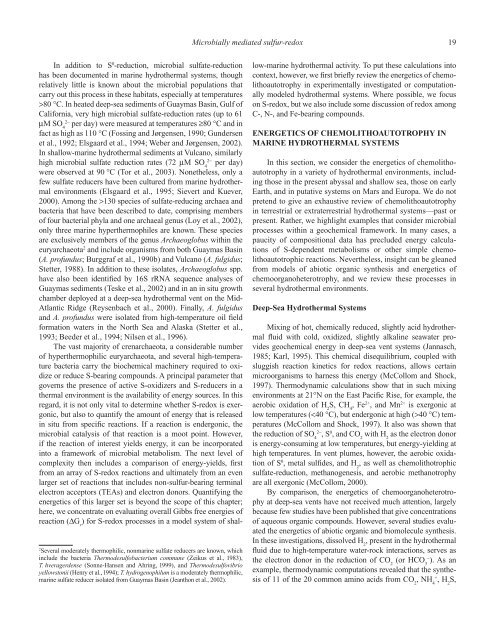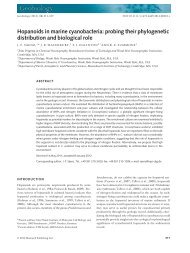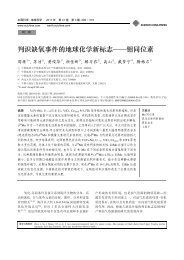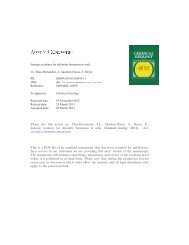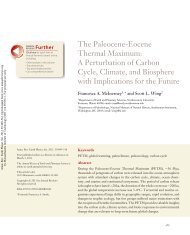Microbially mediated sulfur-redox 192Several moderately thermophilic, nonmarine sulfate reducers are known, whichinclude the bacteria Thermodesulfobacterium commune (Zeikus et al., 1983),T. hveragerdense (Sonne-Hansen <strong>and</strong> Ahring, 1999), <strong>and</strong> Thermodesulfovibrioyellowstonii (Henry et al., 1994); T. hydrogenophilum is a moderately thermo philic,marine sulfate reducer isolated from Guaymas Basin (Jeanthon et al., 2002).In addition to S 0 -reduction, microbial sulfate-reductionhas been documented in marine hydrothermal systems, thoughrelatively little is known about the microbial populations thatcarry out this process in these habitats, especially at temperatures>80 °C. In heated deep-sea sediments of Guaymas Basin, Gulf ofCalifornia, very high microbial sulfate-reduction rates (up to 61µM SO 42−per day) were measured at temperatures ≥80 °C <strong>and</strong> infact as high as 110 °C (Fossing <strong>and</strong> Jørgensen, 1990; Gundersenet al., 1992; Elsgaard et al., 1994; Weber <strong>and</strong> Jørgensen, 2002).In shallow-marine hydrothermal sediments at Vulcano, similarlyhigh microbial sulfate reduction rates (72 µM SO 42−per day)were observed at 90 °C (Tor et al., 2003). Nonetheless, only afew sulfate reducers have been cultured from marine hydrothermalenvironments (Elsgaard et al., 1995; Sievert <strong>and</strong> Kuever,2000). Among the >130 species of sulfate-reducing archaea <strong>and</strong>bacteria that have been described to date, comprising membersof four bacterial phyla <strong>and</strong> one archaeal genus (Loy et al., 2002),only three marine hyperthermophiles are known. These speciesare exclusively members of the genus Archaeoglobus within theeuryarchaeota 2 <strong>and</strong> include organisms from both Guaymas Basin(A. profundus; Burggraf et al., 1990b) <strong>and</strong> Vulcano (A. fulgidus;Stetter, 1988). In addition to these isolates, Archaeoglobus spp.have also been identified by 16S rRNA sequence analyses ofGuaymas sediments (Teske et al., 2002) <strong>and</strong> in an in situ growthchamber deployed at a deep-sea hydrothermal vent on the Mid-Atlantic Ridge (Reysenbach et al., 2000). Finally, A. fulgidus<strong>and</strong> A. profundus were isolated from high-temperature oil fieldformation waters in the North Sea <strong>and</strong> Alaska (Stetter et al.,1993; Beeder et al., 1994; Nilsen et al., 1996).The vast majority of crenarchaeota, a considerable numberof hyperthermophilic euryarchaeota, <strong>and</strong> several high-temperaturebacteria carry the biochemical machinery required to oxidizeor reduce S-bearing compounds. A principal parameter thatgoverns the presence of active S-oxidizers <strong>and</strong> S-reducers in athermal environment is the availability of energy sources. In thisregard, it is not only vital to determine whether S-redox is exergonic,but also to quantify the amount of energy that is releasedin situ from specific reactions. If a reaction is endergonic, themicrobial catalysis of that reaction is a moot point. However,if the reaction of interest yields energy, it can be incorporatedinto a framework of microbial metabolism. The next level ofcomplexity then includes a comparison of energy-yields, firstfrom an array of S-redox reactions <strong>and</strong> ultimately from an evenlarger set of reactions that includes non-sulfur-bearing terminalelectron acceptors (TEAs) <strong>and</strong> electron donors. Quantifying theenergetics of this larger set is beyond the scope of this chapter;here, we concentrate on evaluating overall Gibbs free energies ofreaction (∆G r) for S-redox processes in a model system of shallow-marinehydrothermal activity. To put these calculations intocontext, however, we first briefly review the energetics of chemolithoautotrophyin experimentally investigated or computationallymodeled hydrothermal systems. Where possible, we focuson S-redox, but we also include some discussion of redox amongC-, N-, <strong>and</strong> Fe-bearing compounds.ENERGETICS OF CHEMOLITHOAUTOTROPHY INMARINE HYDROTHERMAL SYSTEMSIn this section, we consider the energetics of chemolithoautotrophyin a variety of hydrothermal environments, includingthose in the present abyssal <strong>and</strong> shallow sea, those on earlyEarth, <strong>and</strong> in putative systems on Mars <strong>and</strong> Europa. We do notpretend to give an exhaustive review of chemolithoautotrophyin terrestrial or extraterrestrial hydrothermal systems—past orpresent. Rather, we highlight examples that consider microbialprocesses within a geochemical framework. In many cases, apaucity of compositional data has precluded energy calculationsof S-dependent metabolisms or other simple chemolithoautotrophicreactions. Nevertheless, insight can be gleanedfrom models of abiotic organic synthesis <strong>and</strong> energetics ofchemoorganoheterotrophy, <strong>and</strong> we review these processes inseveral hydrothermal environments.Deep-Sea Hydrothermal SystemsMixing of hot, chemically reduced, slightly acid hydrothermalfluid with cold, oxidized, slightly alkaline seawater providesgeochemical energy in deep-sea vent systems (Jannasch,1985; Karl, 1995). This chemical disequilibrium, coupled withsluggish reaction kinetics for redox reactions, allows certainmicroorganisms to harness this energy (McCollom <strong>and</strong> Shock,1997). Thermodynamic calculations show that in such mixingenvironments at 21°N on the East Pacific Rise, for example, theaerobic oxidation of H 2S, CH 4, Fe 2+ , <strong>and</strong> Mn 2+ is exergonic atlow temperatures (40 °C) temperatures(McCollom <strong>and</strong> Shock, 1997). It also was shown thatthe reduction of SO 42−, S 0 , <strong>and</strong> CO 2with H 2as the electron donoris energy-consuming at low temperatures, but energy-yielding athigh temperatures. In vent plumes, however, the aerobic oxidationof S 0 , metal sulfides, <strong>and</strong> H 2, as well as chemolithotrophicsulfate-reduction, methanogenesis, <strong>and</strong> aerobic methanotrophyare all exergonic (McCollom, 2000).By comparison, the energetics of chemoorganoheterotrophyat deep-sea vents have not received much attention, largelybecause few studies have been published that give concentrationsof aqueous organic compounds. However, several studies evaluatedthe energetics of abiotic organic <strong>and</strong> biomolecule synthesis.In these investigations, dissolved H 2, present in the hydrothermalfluid due to high-temperature water-rock interactions, serves asthe electron donor in the reduction of CO 2(or HCO 3−). As anexample, thermodynamic computations revealed that the synthesisof 11 of the 20 common amino acids from CO 2, NH 4+, H 2S,
20 J.P. Amend, K.L. Rogers, <strong>and</strong> D.R. Meyer-Dombard<strong>and</strong> H 2is exergonic at 100 °C in a deep-sea vent mixing zone,<strong>and</strong> the synthesis of all 20 amino acids is energetically favoredin a 100 °C hydrothermal fluid relative to the synthesis in cold,oxidized seawater (Amend <strong>and</strong> Shock, 1998). Further, Shock <strong>and</strong>Schulte (1998) demonstrated that as hydrothermal fluids mixwith seawater, it is thermodynamically feasible for much or allof the inorganic carbon to be converted to a mixture of carboxylicacids, alcohols, <strong>and</strong> ketones. The thermodynamic drive fororganic synthesis in deep-sea hydrothermal systems indicatesthat carbon sources required for chemoorganoheterotrophy maybe produced abiotically <strong>and</strong> be subsequently available for microbialmetabolism.Shallow-Sea Hydrothermal SystemsWith respect to microbial metabolism, shallow marinehydrothermal systems differ from their deep counterparts inseveral ways. These include their proximity to the oxygen-richatmosphere, significantly lower hydrostatic pressures, generallylower temperatures of the vent fluid, the likely presence of photosynthesizers<strong>and</strong> associated organic matter, the impact of subaeriall<strong>and</strong>masses <strong>and</strong>, hence, the transport of organic <strong>and</strong> inorganiccompounds due to weathering <strong>and</strong> human activities. However,zones of mixing between vent fluids <strong>and</strong> seawater occur in bothshallow <strong>and</strong> deep marine hydrothermal systems. In addition, inboth types of systems, some of the same chemotrophic organismsare found, <strong>and</strong> energy-yielding, but kinetically inhibited redoxreactions are required for organisms to thrive. Arguably the beststudiedsite of hyperthermophily is the shallow vent system ofVulcano, with approximately one-third of all known hyperthermophilicgenera identified in culturing studies. It was shownrecently that in the beach sediments <strong>and</strong> submarine vent fluidsat Vulcano, exergonic reactions include a wide variety of TEAs(Amend et al., 2003b). Reactions with O 2, NO 3−, <strong>and</strong> Fe(III)release by far the most energy per electron transferred, <strong>and</strong> largedifferences in ∆G r(up to ~60 kJ/mol e − ) for Fe-redox reactionswere noted. These differences were due predominantly to variationsin the in situ concentrations of Fe 2+ , H + , <strong>and</strong> H 2, <strong>and</strong> not dueto the differences in temperature (up to ~45 °C). The energeticsof S-dependent chemolithotrophy <strong>and</strong> chemoorganotrophy atVulcano are discussed in the section “Energetics of <strong>Sulfur</strong>-Redoxat Vulcano: A Case Study of Shallow Marine Vents” below.Early EarthModels of Earth’s history <strong>and</strong> evolution show that marinehydrothermal systems were likely more numerous <strong>and</strong> dynamicon early Earth than they are today. Such systems have probablybeen populated by microorganisms for billions of years (Rasmussen,2000), making them the oldest continuously inhabitedecosystems on Earth (Reysenbach <strong>and</strong> Shock, 2002). Much ofthe attention regarding hydrothermal environments in the Hadean(>3.8 Ga) <strong>and</strong> Early Archean (3.8–3.4 Ga) is linked to origin oflife hypotheses, <strong>and</strong> several recent publications deal at lengthwith this topic. For a treatise on the emergence of chemolithoautotrophiclife from abiotic geochemistry in Hadean hydrothermalsystems, see Martin <strong>and</strong> Russell (2003). Shock et al. (2000) providea comparison of two of the most influential origin of life theories—onethat forces the emergence of heterotrophic life froman organic-rich soup under the cover of a reducing atmosphere(Oparin, 1924; Haldane, 1929; Oparin, 1936; Miller, 1957; Miller<strong>and</strong> Urey, 1959; Lazcano <strong>and</strong> Miller, 1996; Miller et al., 1997;Lazcano <strong>and</strong> Miller, 1999; Miyakawa et al., 2002), <strong>and</strong> the otherthat leads to the conclusion that the first organisms were autotrophic<strong>and</strong> a natural consequence of ordinary geologic forces <strong>and</strong>inescapable chemical disequilibrium in marine hydrothermalsystems (Baross <strong>and</strong> Hoffman, 1985; Wächtershäuser, 1988,1990, 1992; Shock et al., 1995; Russell <strong>and</strong> Hall, 1997; Huber<strong>and</strong> Wächtershäuser, 1998; Shock et al., 1998; Wächtershäuser,1998; Huber et al., 2003). It is worth reiterating that not only isthe chemical pathway uncertain that led from an abiotic planet toone that harbors a brilliant diversity of life forms, but the timingof this event remains in question. A window of time that seemed,until recently, to be securely bracketed by the age of the Earth at4.55 Ga (Brown <strong>and</strong> Mussett, 1993) <strong>and</strong> the age of the earliestbona fide fossils at 3.465 Ga (Schopf et al., 2002), has now widenedwith the controversy regarding the evidence of these oldestfossils (Brasier et al., 2002; Pasteris <strong>and</strong> Wopenka, 2002).Owing to the dearth of requisite compositional data in earlyEarth hydrothermal environments, our summary is limited inthis section to studies of energy budgets for organic synthesis.An important control on the amount of chemical energy availablefor organic synthesis in mixing zones of hydrothermal systems,past or present, is the composition of the host rock (Shock<strong>and</strong> Schulte, 1998). However, the mineralogy of the Hadean<strong>and</strong> Early Archean oceanic crust is only poorly constrained.Sizable uncertainties also pertain for early Earth seawater <strong>and</strong>atmospheric compositions, both of which are incorporated infree energy calculations. A reasonable assumption is that theHadean <strong>and</strong> Early Archean oceanic crust consisted of ultramaficrocks, which, when reacted with seawater, could producestrongly reduced hydrothermal vent fluids (Wetzel <strong>and</strong> Shock,2000). The oxygen-deficient atmosphere would have furtherdepressed the oxidation state of seawater <strong>and</strong> hydrothermalfluid. Under such postulated conditions in the Hadean, synthesisof simple organic compounds from the reduction of CO 2would have been far more favorable than under present conditions,which feature predominantly basalt-hosted hydrothermalsystems <strong>and</strong> an oxygen-rich atmosphere (Shock <strong>and</strong> Schulte,1998). Similar conclusions were reached for amino acid synthesisenergetics in putative hydrothermal systems on early Earth(Amend <strong>and</strong> Shock, 2000). It was shown that the synthesis ofall 20 protein-forming amino acids (at concentrations of 10 −5M) was exergonic in a model Hadean hydrothermal system at100 °C <strong>and</strong> 250 bar. Again, the reducing potential of the modelhydrothermal fluid, due to seawater reactions with hot olivinegabbro (McCollom <strong>and</strong> Shock, 1998), was principally responsiblefor the favorable energetics of organic synthesis.
- Page 2: Sulfur Biogeochemistry—Past and P
- Page 8: Preface viisulfurization on the pre
- Page 11 and 12: 2 V. BrüchertThe resulting sulfur
- Page 13 and 14: 4 V. BrüchertFigure 1. Phylogeneti
- Page 15 and 16: 6 V. Brüchertnot yet been resolved
- Page 17 and 18: 8 V. BrüchertEFFECT OF ELECTRON DO
- Page 19 and 20: 10 V. Brüchertfractionation factor
- Page 21 and 22: 12 V. BrüchertFigure 4. Depth prof
- Page 23 and 24: 14 V. Brüchertto derive isotope fr
- Page 25 and 26: 16 V. BrüchertRudnicki, M.D., Elde
- Page 30 and 31: Microbially mediated sulfur-redox 2
- Page 32 and 33: Microbially mediated sulfur-redox 2
- Page 34 and 35: Microbially mediated sulfur-redox 2
- Page 36 and 37: Microbially mediated sulfur-redox 2
- Page 38 and 39: Microbially mediated sulfur-redox 2
- Page 40 and 41: Microbially mediated sulfur-redox 3
- Page 42 and 43: Microbially mediated sulfur-redox 3
- Page 44 and 45: Geological Society of AmericaSpecia
- Page 46 and 47: Eukaryotes of the Cariaco, Soledad,
- Page 48 and 49: Eukaryotes of the Cariaco, Soledad,
- Page 50 and 51: Eukaryotes of the Cariaco, Soledad,
- Page 52 and 53: Eukaryotes of the Cariaco, Soledad,
- Page 54 and 55: Eukaryotes of the Cariaco, Soledad,
- Page 56: Eukaryotes of the Cariaco, Soledad,
- Page 59 and 60: 50 A. SchippersTABLE 1. DETECTION O
- Page 61 and 62: 52 A. SchippersS 4O 62−+ H 2O →
- Page 63 and 64: 54 A. Schippersthe oxygen molecule
- Page 65 and 66: 56 A. Schippersprohibits biological
- Page 67 and 68: 58 A. SchippersSampleTABLE 4. SULFU
- Page 69 and 70: 60 A. SchippersGeochimica et Cosmoc
- Page 71 and 72: 62 A. SchippersSasaki, K., Tsunekaw
- Page 73 and 74: 64 B.B. Jørgensen and D.C. NelsonI
- Page 75 and 76: 66 B.B. Jørgensen and D.C. NelsonF
- Page 77 and 78:
68 B.B. Jørgensen and D.C. Nelsonq
- Page 79 and 80:
70 B.B. Jørgensen and D.C. Nelsons
- Page 81 and 82:
72 B.B. Jørgensen and D.C. Nelsonp
- Page 83 and 84:
74 B.B. Jørgensen and D.C. NelsonP
- Page 85 and 86:
76 B.B. Jørgensen and D.C. Nelsont
- Page 87 and 88:
78 B.B. Jørgensen and D.C. NelsonF
- Page 89 and 90:
80 B.B. Jørgensen and D.C. NelsonJ
- Page 92 and 93:
Geological Society of AmericaSpecia
- Page 94 and 95:
Formation and degradation of seafl
- Page 96 and 97:
Formation and degradation of seafl
- Page 98 and 99:
Formation and degradation of seafl
- Page 100 and 101:
Formation and degradation of seafl
- Page 102 and 103:
Formation and degradation of seafl
- Page 104 and 105:
Formation and degradation of seafl
- Page 106 and 107:
Geological Society of AmericaSpecia
- Page 108 and 109:
Distribution and fate of sulfur int
- Page 110 and 111:
Distribution and fate of sulfur int
- Page 112 and 113:
Distribution and fate of sulfur int
- Page 114 and 115:
Distribution and fate of sulfur int
- Page 116 and 117:
Distribution and fate of sulfur int
- Page 118 and 119:
Distribution and fate of sulfur int
- Page 120 and 121:
Distribution and fate of sulfur int
- Page 122 and 123:
Distribution and fate of sulfur int
- Page 124 and 125:
Distribution and fate of sulfur int
- Page 126 and 127:
Geological Society of AmericaSpecia
- Page 128 and 129:
- HSO 4SO 2-4H 2 SCO 32-HCO 3-HCO 3
- Page 130 and 131:
Sedimentary pyrite formation 121mar
- Page 132 and 133:
Sedimentary pyrite formation 123The
- Page 134 and 135:
Sedimentary pyrite formation 125Ben
- Page 136 and 137:
Sedimentary pyrite formation 127TAB
- Page 138 and 139:
Sedimentary pyrite formation 129The
- Page 140 and 141:
Sedimentary pyrite formation 131Dek
- Page 142 and 143:
Sedimentary pyrite formation 133Mor
- Page 144 and 145:
Geological Society of AmericaSpecia
- Page 146 and 147:
Recent advances and future research
- Page 148 and 149:
Recent advances and future research
- Page 150 and 151:
Recent advances and future research
- Page 152 and 153:
Recent advances and future research
- Page 154 and 155:
Recent advances and future research
- Page 156 and 157:
Recent advances and future research
- Page 158 and 159:
Recent advances and future research
- Page 160 and 161:
Geological Society of AmericaSpecia
- Page 162 and 163:
Using sulfur isotopes to elucidate
- Page 164 and 165:
Using sulfur isotopes to elucidate
- Page 166 and 167:
Using sulfur isotopes to elucidate
- Page 168 and 169:
Using sulfur isotopes to elucidate
- Page 170 and 171:
Geological Society of AmericaSpecia
- Page 172 and 173:
Sites of anomalous organic reminera
- Page 174 and 175:
Sites of anomalous organic reminera
- Page 176 and 177:
Sites of anomalous organic reminera
- Page 178 and 179:
Sites of anomalous organic reminera
- Page 180 and 181:
Sites of anomalous organic reminera
- Page 182 and 183:
Sites of anomalous organic reminera
- Page 184 and 185:
Sites of anomalous organic reminera
- Page 186 and 187:
Geological Society of AmericaSpecia
- Page 188 and 189:
Sulfur isotope composition of carbo
- Page 190 and 191:
Sulfur isotope composition of carbo
- Page 192 and 193:
Sulfur isotope composition of carbo
- Page 194 and 195:
Sulfur isotope composition of carbo
- Page 196 and 197:
Sulfur isotope composition of carbo
- Page 198 and 199:
Sulfur isotope composition of carbo
- Page 200 and 201:
Sulfur isotope composition of carbo
- Page 202 and 203:
Sulfur isotope composition of carbo
- Page 204 and 205:
Geological Society of AmericaSpecia
- Page 206 and 207:
4 Ga of seawater evolution 197brine
- Page 208 and 209:
4 Ga of seawater evolution 199Figur
- Page 210 and 211:
4 Ga of seawater evolution 201data
- Page 212 and 213:
4 Ga of seawater evolution 203notab
- Page 214:
4 Ga of seawater evolution 205et Co


